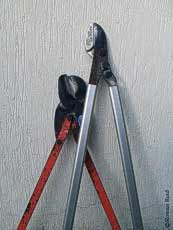|
|
|
Tools
for pruning

A wide range of tools is used for pruning.
They include handsaws, pole saws, loppers, secateurs, chainsaws,
hydraulic secateurs and battery operated loppers. There are
ladders—some of which require harnesses—for those
who are prepared to climb. But there is no tool that is appropriate
for every job.
Handsaws are essential to cut large branches—or those growing
at an acute angle to the stem—accurately. Loppers are quick
and effective for small branches, but risk damaging the bark
if used on hardwoods during the growing season. Pole saws are
effective for pruning small lateral branches from the ground
and controlling epicormic shoots on hardwoods. Pole secateurs
can be useful for pre-emptive pruning from the ground. Chainsaws
are heavy, noisy and not necessary if pruning is done while
branches are small. Pole chainsaws can cause enormous damage
to the branch collar and should never be used. Hydraulic and
compressed air pruners are expensive and cumbersome. Battery
operated secateurs may be dangerous to handle while on a ladder.
Pruning platforms are ideal on flat land, but can be expensive.
Ladders or platforms are necessary for the pruner to work close
to the branch ensuring a clean and accurate cut. Climbing without
a harness is risky and unnecessary. A vertical climbing ladder,
used in combination with a harness (and bicycle helmet) allows
the operator to use loppers safely, reduces the risk of dangerous
falls (compared to conventional ladder pruning), and reduces
operator fatigue.
Back to top
|
|
